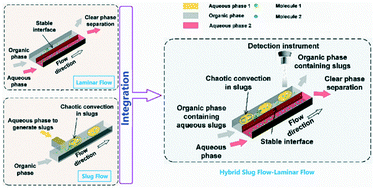Liquid–liquid–liquid three-phase microsystem: hybrid slug flow–laminar flow†
Abstract
Liquid–liquid–liquid three-phase microfluidics provides abundant flow patterns and attractive characteristics that substantially extend the applications of liquid–liquid two-phase microfluidics. Although the manipulation of stable interfaces between adjacent liquid phases is a prerequisite for the successful utilization of three-phase flows, it is challenging. In this study, we develop a novel liquid–liquid–liquid three-phase microsystem that is a hybrid slug flow–laminar flow microchip, in which one aqueous phase makes contact with one organic phase containing slugs of another aqueous phase. The organic phase separates the two aqueous phases, and the three phases co-currently flow. The microchip can simultaneously provide a stable continuous water–oil interface and multiple segregated oil–water interfaces. The design guideline, flow pattern map, and influence rules for the flow rates and the interfacial tension are discussed in detail. Furthermore, a hybrid slug flow–laminar flow microchip is demonstrated for simultaneous extraction/stripping. This three-phase microsystem presents the advantages of slug flow and laminar flow and has potential in various applications such as sample purification, analysis, synthesis, and micro-reactions.



 Please wait while we load your content...
Please wait while we load your content...